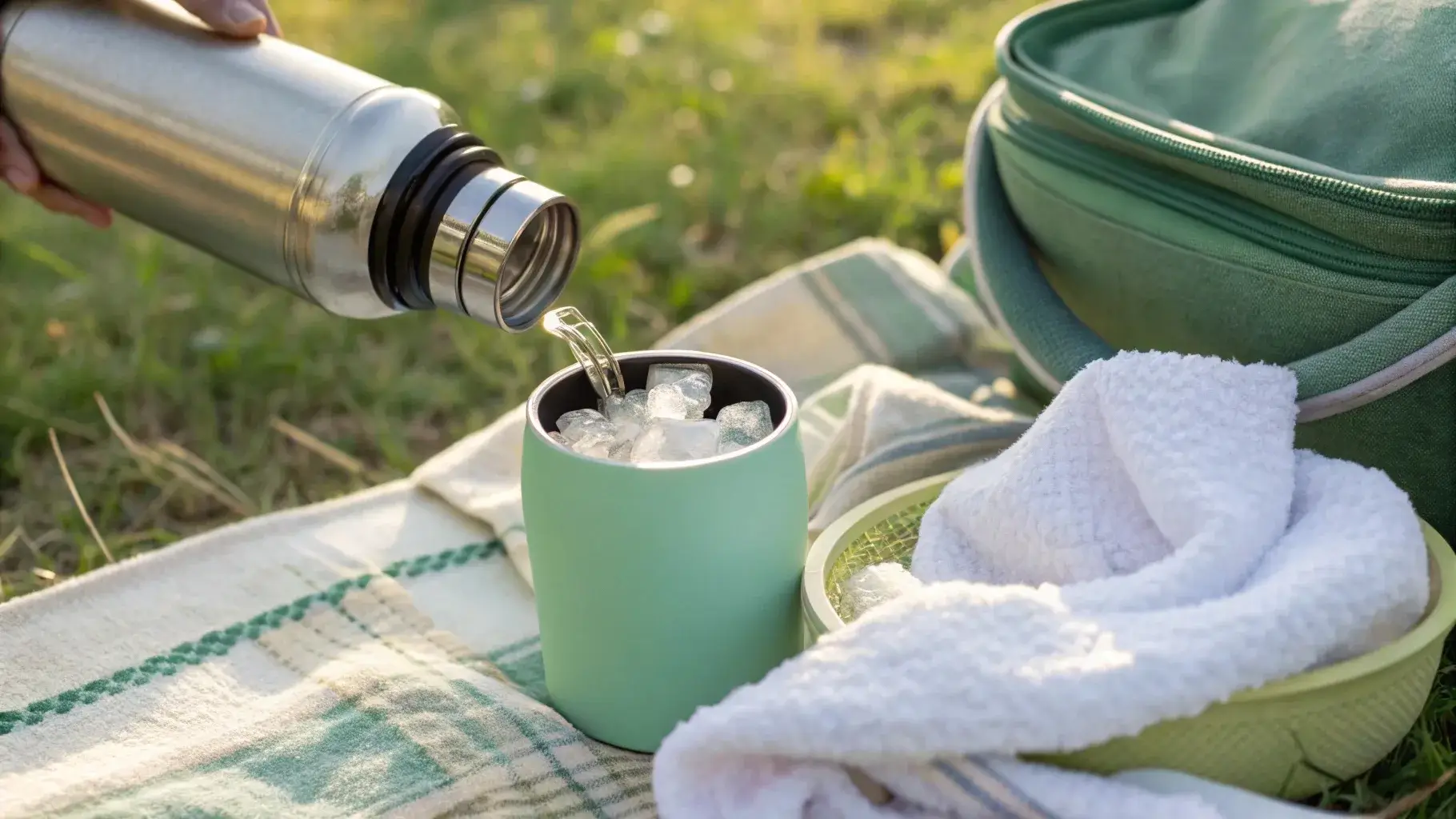
Frozen water bottles are a great way to keep your drink cold for hours. But why does it seem like they’re sweating constantly? Let’s explore some solutions.
Condensation on your frozen water bottle1 can be frustrating. We’ll discuss how to stop this and keep your drink colder, longer.
Let’s dive into practical tips to stop plastic bottles from sweating and maximize their cooling power.
How to Stop Plastic Water Bottles from Sweating?
Plastic water bottles sweat when the cold bottle meets warm, moist air. The moisture in the air condenses onto the cold surface, forming droplets. But what can you do to prevent this?
There are simple methods to reduce condensation on plastic bottles2, such as insulating your bottle or choosing the right kind of bottle material.

The first step is to understand why condensation forms. It’s all about the difference in temperature between the water bottle and the surrounding air. Plastic bottles are not great at insulating, so their exterior can cool down quickly, leading to condensation when exposed to moisture-rich air. You can avoid this issue with a few simple solutions:
Insulate the Bottle
You can buy an insulating sleeve3 or cover for your plastic bottle, which will maintain the bottle’s temperature longer. These covers work by creating an extra layer of protection between the cold bottle and the warm air. Even a thick cotton towel or cloth can work if you’re in a pinch.
Switch to Stainless Steel
Switching from plastic to stainless steel bottles4 can help prevent sweating. Stainless steel bottles are much better at insulating, keeping the cold inside and preventing condensation outside. Many insulated stainless steel bottles come with double-walled vacuum insulation, which can keep your drink cold for hours without the mess of condensation.
Use a Bottle with a Liner
Some advanced plastic water bottles come with an internal lining designed to stop condensation. This feature can be a game-changer if you don’t want to invest in a new material but want to eliminate the sweat problem.
Keep Your Bottle in a Cool Place
It’s a simple step but can make a huge difference. If your bottle sits in direct sunlight or a warm environment, the moisture in the air is more likely to condense. Keep it in a cooler, shaded place to slow down condensation.
How to Make a Frozen Water Bottle Last Longer?
Making a frozen water bottle last longer means more than just keeping it cold – it’s about creating an environment where the ice inside stays frozen for as long as possible.
The key is to enhance the insulation5 and limit the exposure to heat sources.

To extend the lifespan of your frozen water bottle, you need to focus on insulation. The longer the ice stays frozen, the less condensation will form outside. Here are several tips to make sure your frozen bottle lasts longer:
Pre-chill the Bottle
Before you freeze the water, chill the bottle in the refrigerator for a few hours. A cold bottle will take longer to warm up after you freeze it, thus making your ice last longer.
Use Larger Ice Cubes
If possible, use larger ice cubes or blocks6. Smaller pieces of ice will melt faster, but large blocks take longer to thaw. The less surface area the ice has, the longer it stays frozen.
Wrap the Bottle in Insulating Material
As mentioned before, you can wrap your frozen bottle in an insulating material like a neoprene sleeve or a cloth towel. This slows the warming process from the outside and keeps the ice intact longer.
Keep It in a Cooler or Insulated Bag
If you're taking your bottle to work, the gym, or a picnic, keep it in an insulated bag or cooler7. This keeps the surrounding temperature low and gives the bottle an extra layer of protection.
Avoid Frequent Opening
Every time you open the bottle, the cold air escapes and warm air enters, speeding up the melting process. Avoid opening the bottle unless necessary to keep the ice intact for longer periods.
How to Stop Cold Water Bottle Condensation?
Condensation happens when the cold water bottle meets warm air, causing water droplets to form. So, how can you stop this issue?
Understanding the root cause of condensation on cold water bottles8 is key. By adjusting the temperature difference or using specific materials, you can keep your bottle dry.

Condensation forms because warm air hits the cold surface of your bottle. The colder the bottle, the more condensation you’ll get. But there are easy ways to reduce or eliminate condensation:
Use Insulated Water Bottles
One of the best ways to prevent condensation is to use insulated water bottles9. These bottles typically feature double-wall construction with a vacuum-sealed layer between the walls. This prevents the cold air inside from interacting with the outside temperature, stopping condensation before it starts.
Make Sure the Bottle is Fully Closed
If your bottle has a cap or lid, make sure it’s fully sealed. Leaving a gap in the cap can allow moisture from the air to enter the bottle, increasing condensation. A well-sealed bottle will keep the cold air inside and prevent water from accumulating on the exterior.
Keep Your Bottle Away from Humid Areas
Humid environments exacerbate condensation problems. Avoid placing your bottle in direct sunlight, bathrooms, or anywhere there’s excess moisture in the air. The drier the environment, the less condensation will form on the bottle.
Use a Bottle with a Sweating-Proof Design
Some water bottles come with a design meant to reduce or eliminate condensation. These bottles typically have thicker walls or an extra layer of protective coating that reduces moisture from forming.
Why Is My Insulated Water Bottle Sweating?
Even the best insulated bottles can sweat in certain conditions. If your insulated bottle is sweating, it's important to understand the factors at play.
It’s all about the surrounding environment and insulation quality10 of the bottle. Let’s take a closer look.

Insulated water bottles are designed to prevent sweating, but that doesn’t mean they’re immune to it. In fact, sweating can still happen under certain conditions:
Poor Quality Insulation
While most insulated bottles prevent sweating, lower-quality insulation11 may not perform as well as advertised. If the bottle isn’t properly sealed or has weak insulation, the bottle will sweat in warm, humid conditions.
Extreme Temperature Differences
Even the best insulated bottles can sweat when the temperature difference between the inside and outside is extreme. If you take a freezing bottle into a hot, humid environment, condensation is more likely to form, especially if the seal isn’t airtight.
Moisture Inside the Bottle
Sometimes, water from the inside of the bottle can leak out when the bottle is moved or tilted. This moisture can create the appearance of sweating, even if the bottle itself is insulated properly.
Excessive Humidity
In highly humid environments, moisture in the air can form condensation on your bottle, even if the bottle’s temperature remains relatively stable. In these cases, it’s the surrounding environment, not the bottle itself, that causes the issue.
Conclusion
By following the right techniques and understanding how condensation works, you can easily keep your frozen water bottle from sweating and make your drinks last longer.
-
Learn why condensation forms and how to stop it ↩
-
Reduce sweating on bottles using practical insulation solutions ↩
-
Insulating sleeves help block warm air and reduce condensation ↩
-
Stainless steel bottles offer superior insulation and no sweat ↩
-
Enhancing insulation extends how long ice lasts ↩
-
Larger ice melts slower and keeps water colder ↩
-
Insulated coolers help reduce bottle temperature loss ↩
-
Condensation is caused by temperature and humidity differences ↩
-
Insulated bottles prevent heat transfer and stop sweat ↩
-
Sweating can occur due to climate or bottle design flaws ↩
-
Low-quality bottles may not prevent condensation effectively ↩

